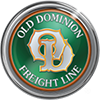Ensuring the safe and secure transportation of your freight involves understanding various aspects of handling and securing freight. Freight that is oversized, improperly unitized fiberboard boxes, and palletized bags are more susceptible to damage during transport. The forces inside a trailer traveling down the road can cause jostling or shifting if the freight is not packed and secured properly, and we want your shipment to be prepared to travel through an LTL network and arrive at your customer’s dock in the same condition it left yours.
Here are some best practices and standards from the National Motor Freight Classification (NMFC) so you can ship with confidence that your freight will arrive in the condition you expect it to.
Handling Overlength Freight
Some freight items exceed standard pallet dimensions, requiring specialized handling to ensure safe transportation. Articles of excessive dimension are those individual articles or handling units that exceed eight feet (96 inches) in length. These items present unique challenges in handling and stowing in trailers shipping LTL freight.
When dealing with overlength freight, it's crucial to:
- Apply Additional Strapping: NMFC Item 680 requires the use of at least two straps in each direction for freight secured on pallets. Palletized freight that exceeds 48” in length or width must have additional strapping to enhance stability and securement.
- Proper Palletization: Ensure overlength freight is palletized appropriately on a single, adequately sized pallet, as per NMFC Item 265.
- Strategic Securement: Use additional strapping or other securement methods as needed to prevent shifting during transit and minimize the risk of damage.
Remember, in the LTL environment, your freight may be loaded and unloaded multiple times and transported in several different trailers. By using properly sized pallets and additional strapping, you can effectively manage overlength freight and mitigate potential risks associated with its transportation.
Unitization of Fiberboard Boxes
Fiberboard boxes are a common packaging solution for shipping various types of goods. Proper unitization of boxes involves careful attention to detail to ensure the integrity of your shipments throughout transit. In recent years, shippers who ship to retailers have faced increased pressures to limit packaging and be “retail ready” when the shipment arrives. However, be cautious with this approach as it can be susceptible to damage.
- Compliance with NMFC Item 222: Ensure fiberboard boxes comply with NMFC Item 222 to guarantee structural integrity and protection during transit. Item 222’s series of rules lists the requirements for fiberboard boxes, including size and weight limits, the strength of the fiberboard used, and the box manufacturer’s certificate (BMC)[1].
- Interior Packaging: Use interior packing materials to cushion and secure items within boxes, minimizing the risk of damage. For example, use materials like bubble wrap, foam peanuts, or air pillows to absorb shock and prevent items from shifting during transport.
- Stacking and Palletization: Stack boxes on pallets, adhering to weight distribution guidelines to ensure stability during handling and transportation. Remember, pallet integrity is equally as important.
- Securement: Ensure the fiberboard boxes are adequately secured to the pallets using plastic film and/or strapping, as required in NMFC Item 680.
Optimizing the security of your boxed shipments and minimizing the likelihood of damage in transit is our goal as your trusted shipping partner.
What is Item 222?
Item 222 in the National Motor Freight Classification outlines the requirements for corrugated fiberboard boxes. It establishes how strong boxes need to be based on their size and weight capacity and dictates the material properties of the cardboard.
Boxes that comply with Item 222 must have a BMC – a box manufacturer’s certificate – printed on the box. The BMC acts as a mark of compliance and tells you a few key characteristics about the box, such as the strength, manufacturer, and maximum weight. By using the correct box, it can minimize damage and reduce claims.
Unitization of Bags
Palletized bags require specialized packaging techniques to ensure their stability and integrity throughout transportation. From palletization to wrapping and strapping, every step plays a crucial role in safeguarding bagged freight.
When unitizing bags on pallets, follow these key steps:
- Proper Palletization: Use a fiberboard tray or a tray and sleeve that extends 20 inches up from the pallet deck to protect bags from sagging over the edges or settling through the pallet deck.
- Strategic Stacking: Stack bags methodically, with three side by side and two perpendicular to maintain stability and cohesion, preventing shifting during transit. Repeat this pattern on the next level, placing three bags atop the two and two perpendicular bags atop the three.
- Securement with Stretch Wrap and Strapping: Wrap palletized bags and packaging together with plastic film and apply at least two straps in each direction to secure the load, minimizing the risk of damage or displacement.
Follow-up Resources
We’re here to help give you peace of mind. Contact your Solutions Specialist with specific questions about your freight and how it will be handled in our national LTL network. For assistance with designing your packaging for the LTL environment, contact a packaging testing laboratory or a packaging consulting firm.
We know each shipment is different and has a unique set of requirements. That’s why we treat each shipment as if it were the most important one. You’ve trusted us to deliver, and we’re here to keep your promise to your customers. Together, we’re tasked with handling and securing each piece of freight while understanding the unique requirements associated with different types of shipments.
Whether dealing with overlength freight, fiberboard boxes, or bags, adhering to industry standards and best practices is essential for optimizing security and minimizing the risk of damage during transit. By following the guidelines outlined above and those specified in the NMFC, you can enhance the safety and reliability of your shipments, ensuring they arrive at their destination in pristine condition.
